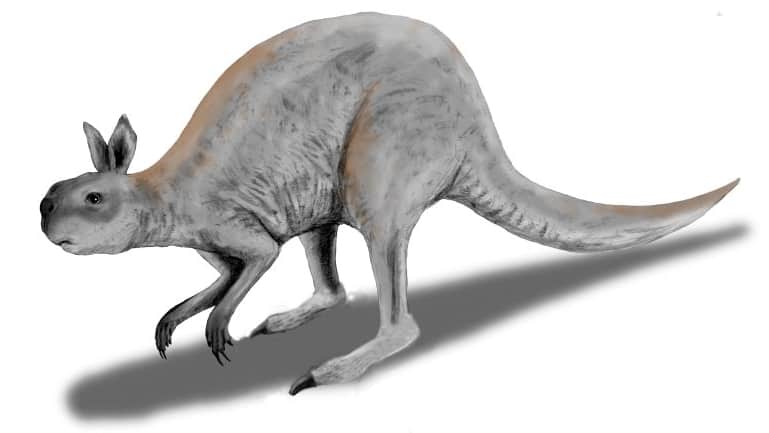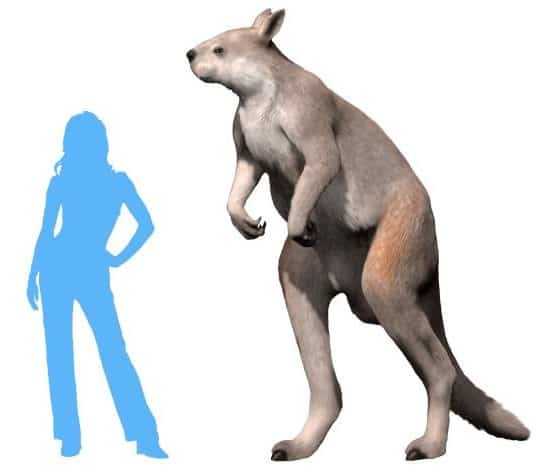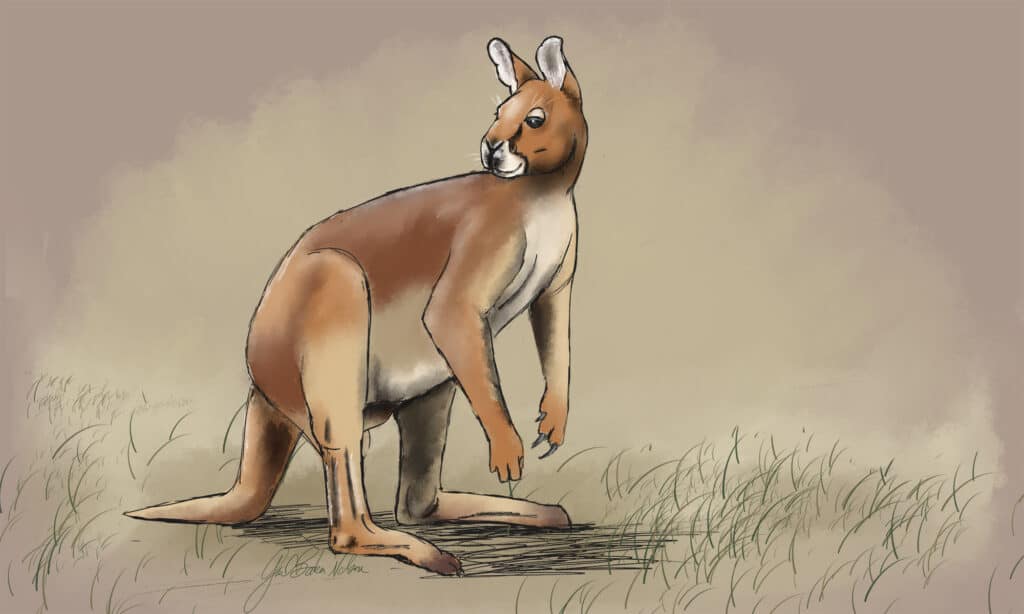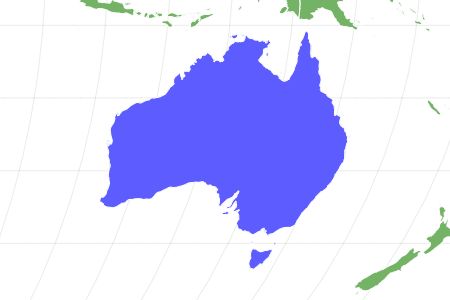Procoptodon
The largest variety of kangaroo to have ever been discovered.
Advertisement
Procoptodon Scientific Classification
Read our Complete Guide to Classification of Animals.
Procoptodon Conservation Status
Procoptodon Facts
- Fun Fact
- The largest variety of kangaroo to have ever been discovered.
- Most Distinctive Feature
- Short face; hoof-like feet; long tail.
View all of the Procoptodon images!
Description and Size
The Procoptodon is a genus of large kangaroos, which were notorious for their significant high and short face. To date, it is the largest variety of kangaroo to have ever been discovered, measuring 6.6 feet tall in the largest specimens. It could weigh between 440 and 530 lbs., though there are many other kangaroo species that are smaller. The largest known Procoptodon was just two inches short of 9 feet tall.
The appearance of the Procoptodon is a lot like what you picture as today’s kangaroos, though it was quite a bit larger. Their faces were short and flat with eyes that pointed forward. Instead of individual toes, the large foot seemingly had a single toe or claw, giving it more of the shape of a horse’s foot. While unusual, this shape helped them to get through open forests and plains with great speed, seeking out leaves and grass as their main diet. Their hands comprised of large claws atop their two incredibly long fingers.
Even though the hop would decidedly be the most natural way for them to move, their weight would make it incredibly hard. Still, researchers are still uncertain whether it may have been the largest mammal to be able to use hopping as its form of locomotion because of this bone structure. Still, the movement at this weight would put the user at a higher risk of breaking a tendon. Their ankles and hip joints were broad, made to withstand the friction caused by twisting or torsion. Their stance suggests that they would keep weight on one leg at a time, and they may have even been an aggressor toward humans with great movement.
Based on the current fossils, the Procoptodon had large and fused lower jaws, giving this animal a distinct chin. It used its incisor to bite local vegetation while feeding, though the last of their premolars came in much later than the rest of their teeth. They had long arms with long curvy claws on their middle fingers, though their overall size suggests that their reach could give them vegetation up to 1.5 times their height.
It is possible that Procoptodon young are small and hairless, remaining in the pouch like today’s kangaroos after they are born.

Based on the shape of its face and molars, scientists believe that Procoptodon was a grazer.
©Nobu Tamura / CC BY 3.0 – License
Diet – What Did the Procoptodon Eat?
Based on the molar patterns and other teeth, scientists believe that the Procoptodon mostly had a diet of trees, shrubs, grass, and other plant life. They seemed to graze as needed, though it has been incredibly difficult to identify a specific diet for any herbivore. They needed to be near a body of water for hydration because their stomach contents suggested that the vegetation consumed was higher in salt.
Habitat – When and Where the Procoptodon Lived
New South Wales and South Australia are the main places where the Procoptodon lived during the Pleistocene Epoch, choosing an environment that was semiarid without trees. However, some parts of the former were cold and wet at the time that this animal would’ve lived there. The area was also notable for sand dunes, woodlands, and savannahs. On Kangaroo Island, their footsteps have also been found.
To date, no fossils have been found in the northern regions of either of these areas.

©By Nobu Tamura – https://spinops.blogspot.com/2020/07/procoptodon-goliah.html, CC BY-SA 4.0, https://commons.wikimedia.org/w/index.php?curid=99474302 – License
Threats And Predators of the Procoptodon
While the size of the Procoptodon might lead you to believe that nothing could threaten its lifespan, it still would’ve been victim to the predators larger than it, like the marsupial lion or a former species of monitor lizard that would come down into the lower vegetation areas. The best way for the Procoptodon to protect itself would’ve been its speed.
Considering the time that researchers believe that the Procoptodon lived, there’s a chance that they encountered humans before they went extinct. In fact, there is some suggestion that the end of the species coincided with the increased number of humans in the area.
Discoveries and Fossils – Where the Procoptodon Was Found
The first time that scientists ever found the first Procoptodon fossil was in New South Wales in Lake Menindee. Since then, specimens have been found in Lake Callabonna, the Darling Downs, Nullarbor Plain, and other sizes. To show the public a preview of what this species probably looked like, a replica is found in the Australian Museum. Of the few skeletons found, scientists have been able to extract their entire bodies.
Extinction – When Did the Procoptodon Die Out?
Resilient and strong, the Procoptodon fossils have been dated as recently as 18,000 years ago, though evidence consistently shows that it lived at least as far back as 45,000 years ago before it went extinct. Researchers link a few possible changes to be due to climate changes during the end of the era. However, since the end of their species overlaps with the earliest humans on record. Further research shows that interaction with humans was inevitable, and researchers believe that the role that they played in the animal’s demise is likely.
The climate didn’t change significantly at the time of the last recorded Procoptodons, further supporting the idea that they may have been killed off ahead by humans. Based on the timelines, humans could’ve existed with them over the course of 10,000 to 15,000 years before they went extinct.
Another possible cause of their extinction is deforestation, which would’ve taken away their main source of nutrients. Still, humans are connected to this deforestation in Australia, due to setting these regions on fire. As researchers continue to study the Procoptodon, they believe that the particular plants that they might’ve eaten would not have been as likely to burn, suggesting that the fires wouldn’t have been enough to starve the species.

Similar Animals to the Procoptodon
Similar animals to the Procoptodon include:
- Diprotodon – This extinct genus of marsupial lived in Australia around the same time. They are one of the original animals of Australia.
- Red kangaroo – This kangaroo is the largest living species in this genus in the world.
- Thylacine – This species of dog is also related to the Tasmanian wolf, and the most recent specimen was seen in the 1930s.
Procoptodon FAQs (Frequently Asked Questions)
When was the Procoptodon alive?
The Procoptodon lived during the Pleistocene Epoch, which covers the last ice age that the Earth went through. It ended 11,700 years ago, and the extinction of this kangaroo species has been linked to the introduction of humans into Australia.
How big was the Procoptodon?
The Procoptodon stood taller than most humans at 6.6 feet tall, and it is the largest kangaroo in existence. It weighed approximately 440 to 530 lbs.
Thank you for reading! Have some feedback for us? Contact the AZ Animals editorial team.
Sources
- Wikipedia, Available here: https://en.wikipedia.org/wiki/Procoptodon
- Australian Museum, Available here: https://australian.museum/learn/australia-over-time/extinct-animals/procoptodon-goliah/
- Prehistoric Wildlife, Available here: http://www.prehistoric-wildlife.com/species/p/procoptodon.html
- The Conversation, Available here: https://theconversation.com/weve-decoded-the-numbat-genome-and-it-could-bring-the-thylacines-resurrection-a-step-closer-176528
- Prehistoric Fauna, Available here: https://prehistoric-fauna.com/Procoptodon-goliah

















